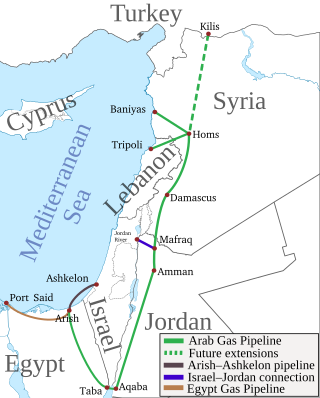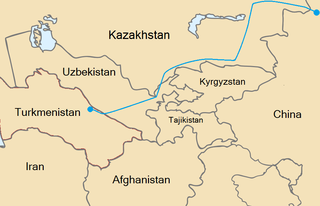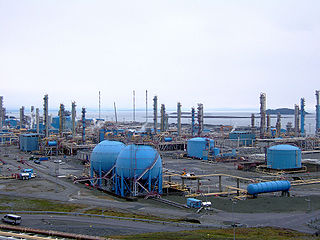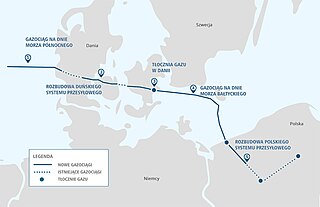
The Langeled pipeline is an underwater gas pipeline transporting Norwegian natural gas to the United Kingdom. Before the completion of the Nord Stream 1 pipeline, it was the longest subsea pipeline in the world.
Gassco is a Norwegian state owned company that operates 7,800 kilometres (4,800 mi) of natural gas pipes transporting annually of 100 billion cubic meter (bcm) of natural gas from the Norwegian continental shelf to Continental Europe and Great Britain.

The Yamal–Europe natural gas pipeline is a 4,107-kilometre-long (2,552 mi) pipeline connecting Russian natural gas fields in the Yamal Peninsula and Western Siberia with Poland and Germany, through Belarus. The Poland portion ceased operating in 2022.

The Arab Gas Pipeline is a natural gas pipeline in the Middle East. It originates near Arish in the Sinai Peninsula and was built to export Egyptian natural gas to Jordan, Syria, and Lebanon, with branch underwater and overland pipelines to and from Israel. It has a total length of 1,200 kilometres (750 mi), constructed at a cost of US$1.2 billion.

The Trans-Mediterranean Pipeline is a natural gas pipeline from Algeria via Tunisia to Sicily and thence to mainland Italy. An extension of the TransMed pipeline delivers Algerian gas to Slovenia.

The Central Asia–China gas pipeline is a natural gas pipeline system from Central Asia to Xinjiang in the People's Republic of China. By connecting Turkmenistan to China’s domestic grid, this pipeline makes it possible to transport gas some 7000 km from Turkmenistan to Shanghai. More than half of Turkmen natural gas exports are delivered to China through the pipeline.
Vesterled is a natural gas pipeline system, which runs from the Heimdal field in the North Sea to St Fergus Gas Plant near Peterhead in Scotland. The name Vesterled is the term used by the Vikings for their westward voyages, i.e. vesterled = "the way westward".
The Franpipe is a 840 kilometres (520 mi) long natural gas pipeline from the Draupner E riser in the North Sea to the receiving terminal at Port Ouest in Dunkirk, France. The gas transported to France originates mainly from Sleipner East and Troll Vest gas fields. The pipeline was officially inaugurated on 9 October 1998.
The Zeepipe is a natural gas transportation system to transport North Sea natural gas to the receiving terminal at Zeebrugge in Belgium.

Europipe II is a natural gas pipeline from the Kårstø processing plant north of Stavanger to a receiving terminal at Dornum in Germany. It came on stream on 1 October 1999.
Netra is a 408 kilometres (254 mi) long natural gas pipeline system in Germany, which runs from the Dornum natural gas receiving facility at the coast of North Sea to Salzwedel in eastern Germany, where it is connected with the JAGAL pipeline. The pipeline is extended to Berlin through the Salzwedel–Berlin connection.
Norpipe is a subsea oil and natural gas pipelines system in the North Sea. It supplies oil from the Norwegian Ekofisk and associated fields in the North Sea to the United Kingdom and natural gas to Germany.

Kårstø is an industrial facility located near the village of Susort, along the Boknafjorden, in the municipality of Tysvær in Rogaland county, Norway. The site features a number of natural gas processing plants that refine natural gas and condensate from the fields in the northern parts of the North Sea, including the Åsgard, Mikkel, and Sleipner gas fields. The Kårstø processing complex is Europe's biggest export port for natural gas liquids (NGL) and the third largest in the world. The industrial site is also the location for the now-closed Kårstø Power Station.
The Statpipe pipeline is a natural gas system, which links northern North Sea gas fields with the Norway's gas export system. It transports gas from Statfjord, Gullfaks, Heimdal, Veslefrikk, Snorre, Brage and Tordis gas fields.

The Baltic Pipe is a natural gas pipeline between Europipe II and Poland. It is a strategic infrastructure project to create a new European gas supply corridor.
Ruhrgas AG was the largest natural gas transportation and trading company based in Essen, Germany. The company was founded in 1926 and it finally ceased to exist on 2 May 2013 when it was merged into E.ON Global Commodities SE.
The Draupner platform is a gas platform for the extraction of natural gas in the North Sea consisting of the Draupner S and E riser platforms. It is located in the Norwegian North Sea block 16/11 160 km (99 mi) offshore from Norway. The complex consists of seven risers and two riser platforms standing in 70 m (230 ft) water depth and linked by a bridge. Draupner E is the first major oil platform using jacket-type construction supported on a bucket foundation and suction anchors. The complex is owned by Gassled and operated by Gassco. The technical service provider is Equinor.
Haltenpipe is a gas transport system which consists of a 250 kilometres (160 mi) long pipeline from the Heidrun field to Tjeldbergodden. It started operation in December 1996, and is operated by Gassco. Transport capacity is 2.2. billion cubic metres per year.

The Świnoujście LNG terminal is a liquefied natural gas (LNG) import terminal at Świnoujście, in the extreme north-west of Poland near the Polish-German border. The LNG terminal is operated by Polskie LNG S.A., a subsidiary of Gaz-System. The cornerstone for construction was laid on 23 March 2011 and it took its first LNG delivery on 11 December 2015. The terminal's regasification capacity is 5 billion cubic metres per annum. The terminal is currently being expanded and once the expansion is complete in 2023, it will have a capacity of 7.5 billion cubic metres per annum and be able to satisfy about half of Poland's annual natural gas demand. Together with the 10 bcm of natural gas that Poland will receive annually from Norway via the Baltic Pipe natural gas pipeline, the Świnoujście LNG terminal will allow Poland to achieve its long-term goal of becoming fully independent of Russian natural gas, which had previously been the source of almost all of the country's natural gas.









